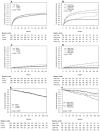Impact of smoking and smoking cessation on oncologic outcomes in primary non-muscle-invasive bladder cancer
- PMID: 22925575
- PMCID: PMC3969986
- DOI: 10.1016/j.eururo.2012.08.025
Impact of smoking and smoking cessation on oncologic outcomes in primary non-muscle-invasive bladder cancer
Abstract
Background: Cigarette smoking is the best-established risk factor for urothelial carcinoma (UC) development, but the impact on oncologic outcomes remains poorly understood.
Objective: To analyse the effects of smoking status, cumulative exposure, and time from smoking cessation on the prognosis of patients with primary non-muscle-invasive bladder cancer (NMIBC).
Design, setting, and participants: We collected smoking data from 2043 patients with primary NMIBC. Smoking variables included smoking status, average number of cigarettes smoked per day (CPD), duration in years, and time since smoking cessation. Lifetime cumulative smoking exposure was categorised as light short term (≤ 19 CPD, ≤ 19.9 yr), light long term (≤ 19 CPD, ≥ 20 yr), heavy short term (≥ 20 CPD, ≤ 19.9 yr) and heavy long term (≥ 20 CPD, ≥ 20 yr). The median follow-up in this retrospective study was 49 mo.
Interventions: Transurethral resection of the bladder with or without intravesical instillation therapy.
Outcome measurements and statistical analysis: Univariable and multivariable logistic regression and competing risk regression analyses assessed the effects of smoking on outcomes.
Results and limitations: There was no difference in clinicopathologic factors among never (24%), former (47%), and current smokers (29%). Smoking status was associated with the cumulative incidence of disease progression in multivariable analysis (p=0.003); current smokers had the highest cumulative incidences. Among current and former smokers, cumulative smoking exposure was associated with disease recurrence (p<0.001), progression (p<0.001), and overall survival (p<0.001) in multivariable analyses that adjusted for the effects of standard clinicopathologic factors and smoking status; heavy long-term smokers had the worst outcomes, followed by light long-term, heavy short-term, and light short-term smokers. Smoking cessation >10 yr reduced the risk of disease recurrence (hazard ratio [HR]: 0.66; 95% confidence interval [CI], 0.52-0.84; p<0.001) and progression (HR: 0.42; 95% CI, 0.22-0.83; p=0.036) in multivariable analyses. The study is limited by its retrospective nature.
Conclusions: Smoking status and a higher cumulative smoking exposure are associated with worse prognosis in patients with NMIBC. Smoking cessation >10 yr abrogates this detrimental effect. These findings underscore the need for integrated smoking cessation and prevention programmes in the management of NMIBC patients.
Copyright © 2012 European Association of Urology. Published by Elsevier B.V. All rights reserved.
Figures

References
-
- Siegel R, Naishadham D, Jemal A. Cancer statistics, 2012. CA Cancer J Clin. 2012;62:10–29. - PubMed
-
- Babjuk M, Oosterlinck W, Sylvester R, et al. European Association of Urology (EAU). EAU guidelines on non–muscle-invasive urothelial carcinoma of the bladder, the 2011 update. Eur Urol. 2011;59:997–1008. - PubMed
-
- Fernandez-Gomez J, Madero R, Solsona E, et al. Predicting nonmuscle invasive bladder cancer recurrence and progression in patients treated with bacillus Calmette-Guerin: the CUETO scoring model. J Urol. 2009;182:2195–203. - PubMed
-
- Sylvester RJ, van der Meijden AP, Oosterlinck W, et al. Predicting recurrence and progression in individual patients with stage Ta T1 bladder cancer using EORTC risk tables: a combined analysis of 2596 patients from seven EORTC trials. Eur Urol. 2006;49:466–75. discussion 475-7. - PubMed
-
- Stenzl A, Hennenlotter J, Schilling D. Can we still afford bladder cancer? Curr Opin Urol. 2008;18:488–92. - PubMed
MeSH terms
Grants and funding
LinkOut - more resources
Full Text Sources
Other Literature Sources
Medical

